Enhancing Team Effectiveness: Candidate Fitness and Training Programs
VerifiedAdded on 2022/11/14
|7
|1480
|262
Homework Assignment
AI Summary
This assignment explores the essential processes involved in creating and maintaining highly effective teams within an organizational setting. The solution addresses the crucial steps in determining candidate fitness for assigned roles, including academic credentials, thinking capacity, and practical assessments. It delves into the design of cross-functional training programs, emphasizing the importance of aligning training with the organization's vision and mission to boost employee skills and performance. Furthermore, the assignment examines the role of training topics in promoting team diversity, fostering intergroup relations, and enhancing plant productivity. Specifically, it highlights the significance of cultural awareness, communication skills, and conflict resolution in creating a harmonious and productive work environment. The analysis draws on various research studies to support the proposed strategies for team development and management.
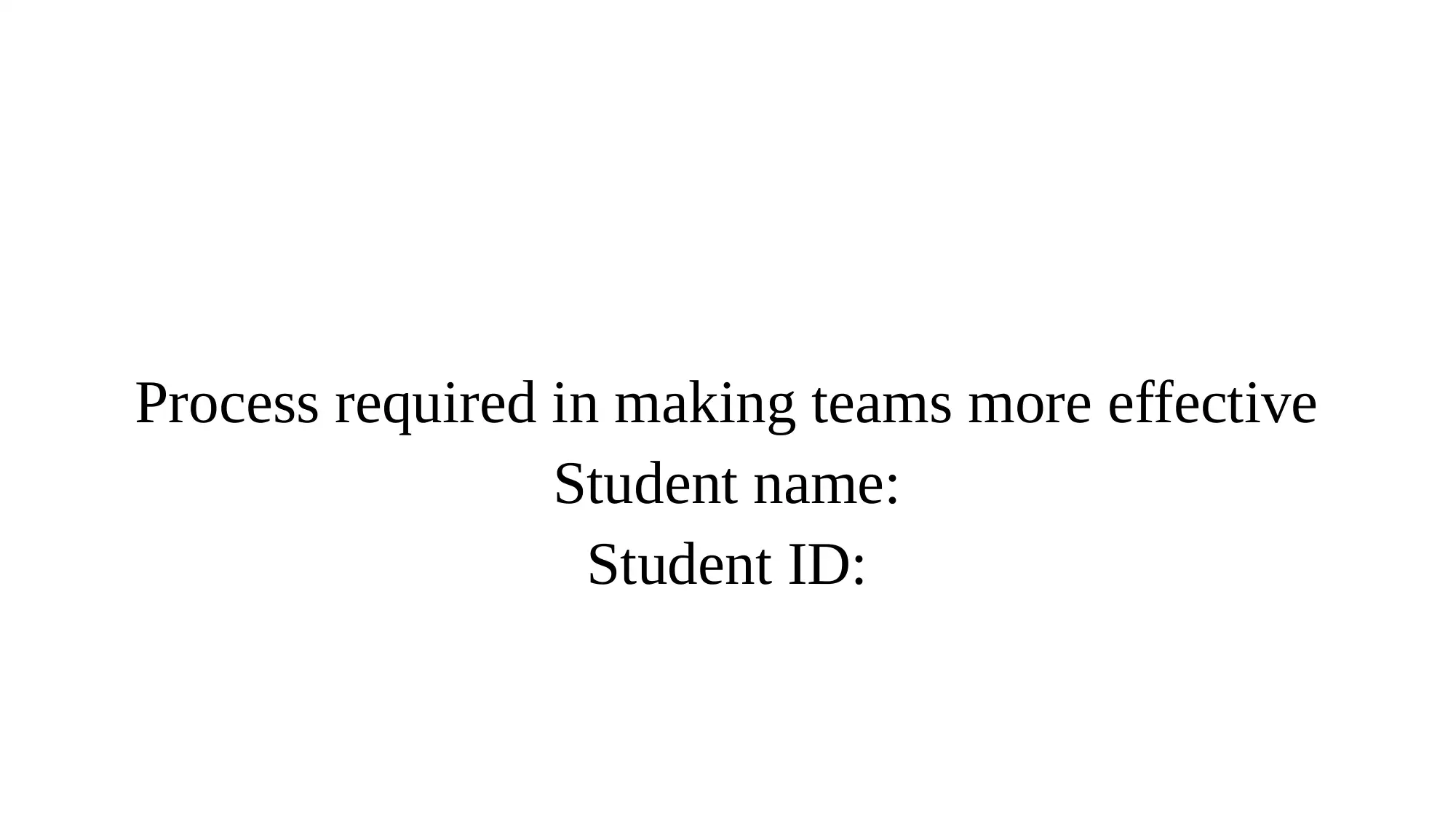
Process required in making teams more effective
Student name:
Student ID:
Student name:
Student ID:
Paraphrase This Document
Need a fresh take? Get an instant paraphrase of this document with our AI Paraphraser
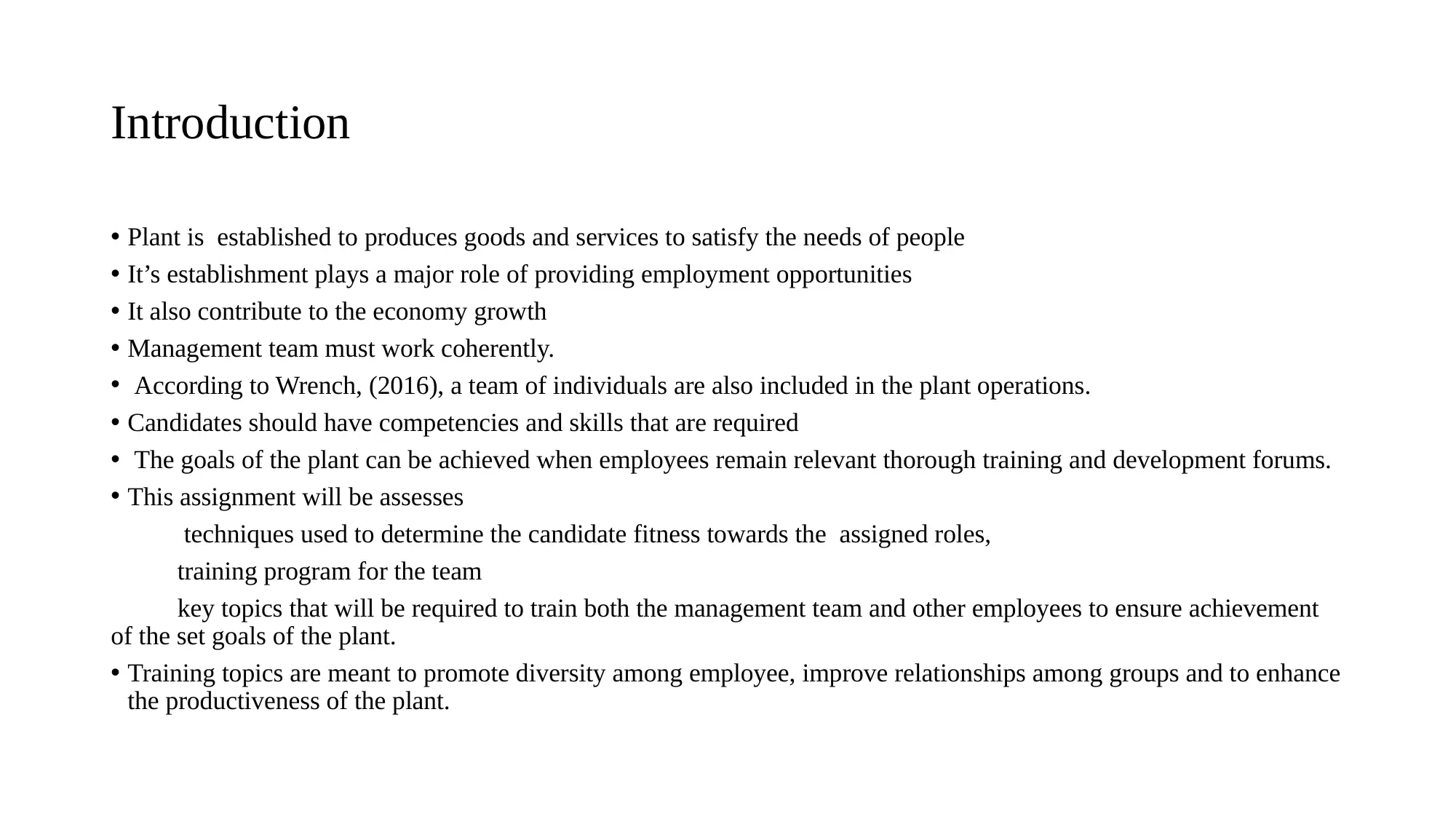
Introduction
• Plant is established to produces goods and services to satisfy the needs of people
• It’s establishment plays a major role of providing employment opportunities
• It also contribute to the economy growth
• Management team must work coherently.
• According to Wrench, (2016), a team of individuals are also included in the plant operations.
• Candidates should have competencies and skills that are required
• The goals of the plant can be achieved when employees remain relevant thorough training and development forums.
• This assignment will be assesses
techniques used to determine the candidate fitness towards the assigned roles,
training program for the team
key topics that will be required to train both the management team and other employees to ensure achievement
of the set goals of the plant.
• Training topics are meant to promote diversity among employee, improve relationships among groups and to enhance
the productiveness of the plant.
• Plant is established to produces goods and services to satisfy the needs of people
• It’s establishment plays a major role of providing employment opportunities
• It also contribute to the economy growth
• Management team must work coherently.
• According to Wrench, (2016), a team of individuals are also included in the plant operations.
• Candidates should have competencies and skills that are required
• The goals of the plant can be achieved when employees remain relevant thorough training and development forums.
• This assignment will be assesses
techniques used to determine the candidate fitness towards the assigned roles,
training program for the team
key topics that will be required to train both the management team and other employees to ensure achievement
of the set goals of the plant.
• Training topics are meant to promote diversity among employee, improve relationships among groups and to enhance
the productiveness of the plant.

Ways of determining candidate fitness
• During interviews, human resource managers meets with different individuals in their company.
• In this case, they have the responsibility of determining and selecting candidates with the proposed skills
• According to von Thiele Schwarz, Hasson, & Tafvelin, (2016), individuals are determined whether they have
the required skills through interviews
• Interviews comes after the vacant positions are announced
• Possible individuals apply and invited for interviews.
• Candidates fitness can be achieved through : academic credentials, thinking and application capacity and
performing of a practical related to the intendent roles
• Minimum marks are awarded depending on the professional qualifications
• Academic credentials indicate the level of education to acquire relevant skills in their major areas.
• These credentials are used as a key proof for competencies of the job. The manager can also ask candidates
questions relating to the job roles
• this enable manager to insight of the candidate’s application level and their thinking capacity.
• higher level of thinking capacity is required while answering the questions
• During interviews, human resource managers meets with different individuals in their company.
• In this case, they have the responsibility of determining and selecting candidates with the proposed skills
• According to von Thiele Schwarz, Hasson, & Tafvelin, (2016), individuals are determined whether they have
the required skills through interviews
• Interviews comes after the vacant positions are announced
• Possible individuals apply and invited for interviews.
• Candidates fitness can be achieved through : academic credentials, thinking and application capacity and
performing of a practical related to the intendent roles
• Minimum marks are awarded depending on the professional qualifications
• Academic credentials indicate the level of education to acquire relevant skills in their major areas.
• These credentials are used as a key proof for competencies of the job. The manager can also ask candidates
questions relating to the job roles
• this enable manager to insight of the candidate’s application level and their thinking capacity.
• higher level of thinking capacity is required while answering the questions
⊘ This is a preview!⊘
Do you want full access?
Subscribe today to unlock all pages.

Trusted by 1+ million students worldwide
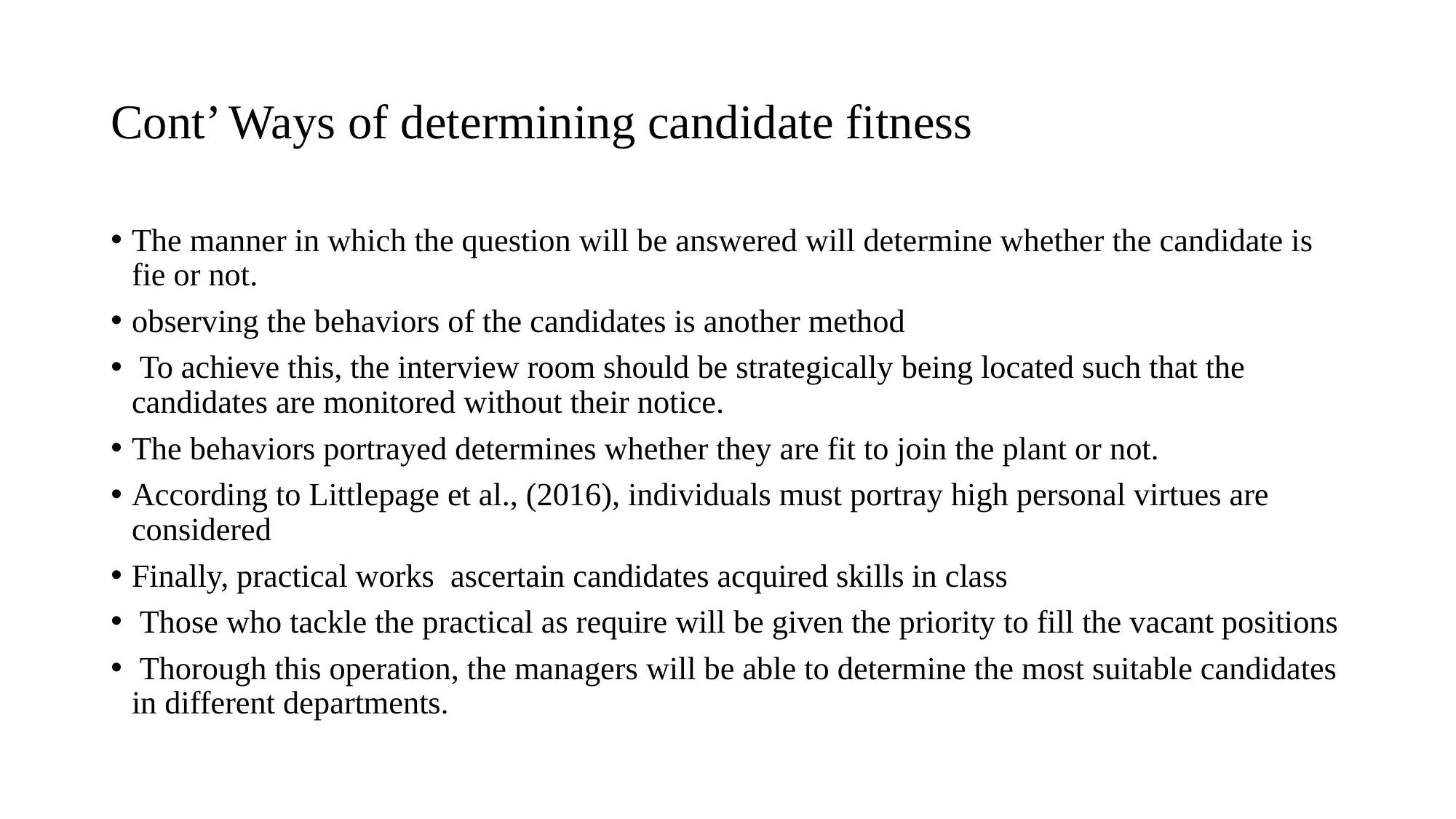
Cont’ Ways of determining candidate fitness
• The manner in which the question will be answered will determine whether the candidate is
fie or not.
• observing the behaviors of the candidates is another method
• To achieve this, the interview room should be strategically being located such that the
candidates are monitored without their notice.
• The behaviors portrayed determines whether they are fit to join the plant or not.
• According to Littlepage et al., (2016), individuals must portray high personal virtues are
considered
• Finally, practical works ascertain candidates acquired skills in class
• Those who tackle the practical as require will be given the priority to fill the vacant positions
• Thorough this operation, the managers will be able to determine the most suitable candidates
in different departments.
• The manner in which the question will be answered will determine whether the candidate is
fie or not.
• observing the behaviors of the candidates is another method
• To achieve this, the interview room should be strategically being located such that the
candidates are monitored without their notice.
• The behaviors portrayed determines whether they are fit to join the plant or not.
• According to Littlepage et al., (2016), individuals must portray high personal virtues are
considered
• Finally, practical works ascertain candidates acquired skills in class
• Those who tackle the practical as require will be given the priority to fill the vacant positions
• Thorough this operation, the managers will be able to determine the most suitable candidates
in different departments.
Paraphrase This Document
Need a fresh take? Get an instant paraphrase of this document with our AI Paraphraser
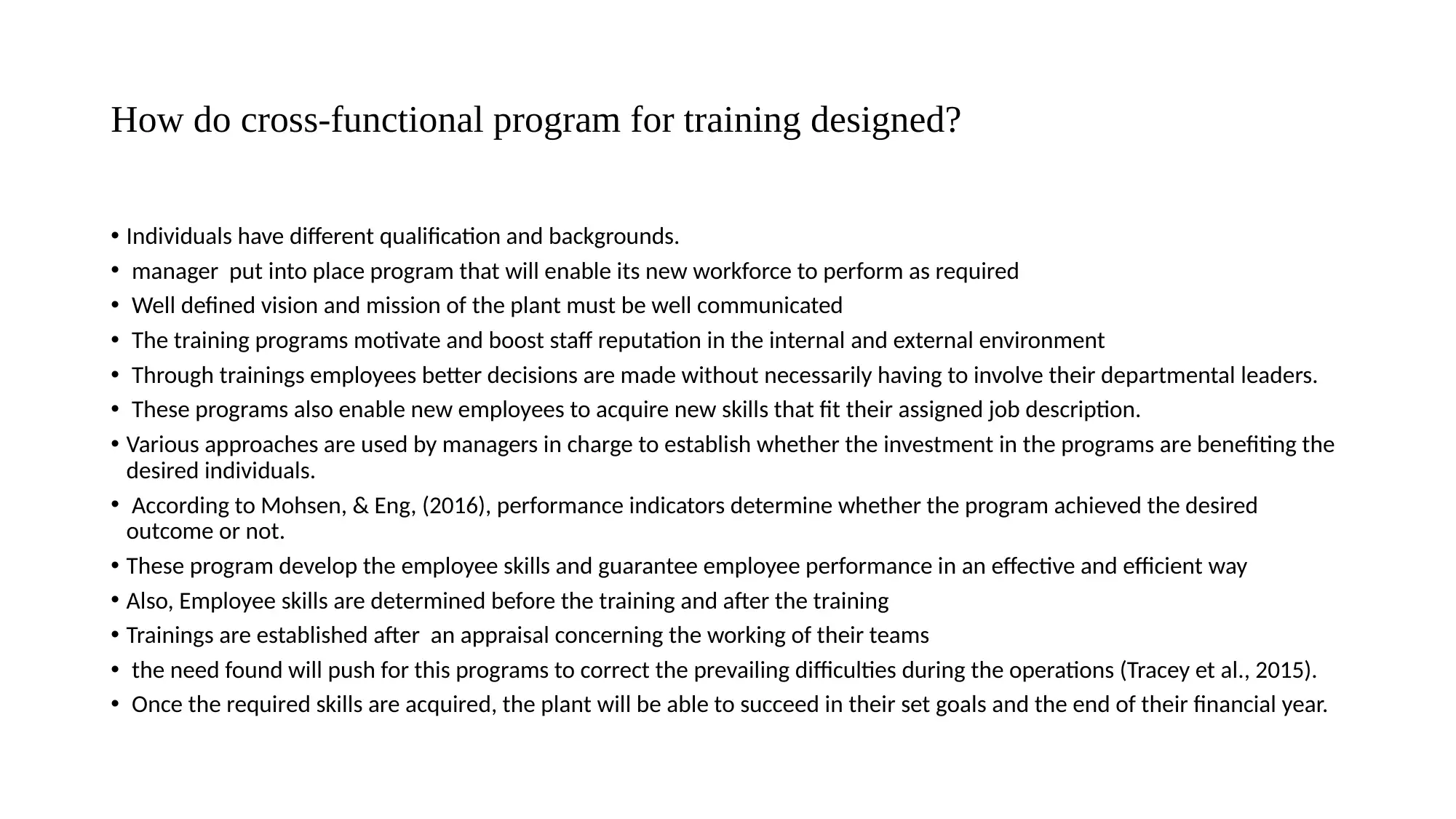
How do cross-functional program for training designed?
• Individuals have different qualification and backgrounds.
• manager put into place program that will enable its new workforce to perform as required
• Well defined vision and mission of the plant must be well communicated
• The training programs motivate and boost staff reputation in the internal and external environment
• Through trainings employees better decisions are made without necessarily having to involve their departmental leaders.
• These programs also enable new employees to acquire new skills that fit their assigned job description.
• Various approaches are used by managers in charge to establish whether the investment in the programs are benefiting the
desired individuals.
• According to Mohsen, & Eng, (2016), performance indicators determine whether the program achieved the desired
outcome or not.
• These program develop the employee skills and guarantee employee performance in an effective and efficient way
• Also, Employee skills are determined before the training and after the training
• Trainings are established after an appraisal concerning the working of their teams
• the need found will push for this programs to correct the prevailing difficulties during the operations (Tracey et al., 2015).
• Once the required skills are acquired, the plant will be able to succeed in their set goals and the end of their financial year.
• Individuals have different qualification and backgrounds.
• manager put into place program that will enable its new workforce to perform as required
• Well defined vision and mission of the plant must be well communicated
• The training programs motivate and boost staff reputation in the internal and external environment
• Through trainings employees better decisions are made without necessarily having to involve their departmental leaders.
• These programs also enable new employees to acquire new skills that fit their assigned job description.
• Various approaches are used by managers in charge to establish whether the investment in the programs are benefiting the
desired individuals.
• According to Mohsen, & Eng, (2016), performance indicators determine whether the program achieved the desired
outcome or not.
• These program develop the employee skills and guarantee employee performance in an effective and efficient way
• Also, Employee skills are determined before the training and after the training
• Trainings are established after an appraisal concerning the working of their teams
• the need found will push for this programs to correct the prevailing difficulties during the operations (Tracey et al., 2015).
• Once the required skills are acquired, the plant will be able to succeed in their set goals and the end of their financial year.
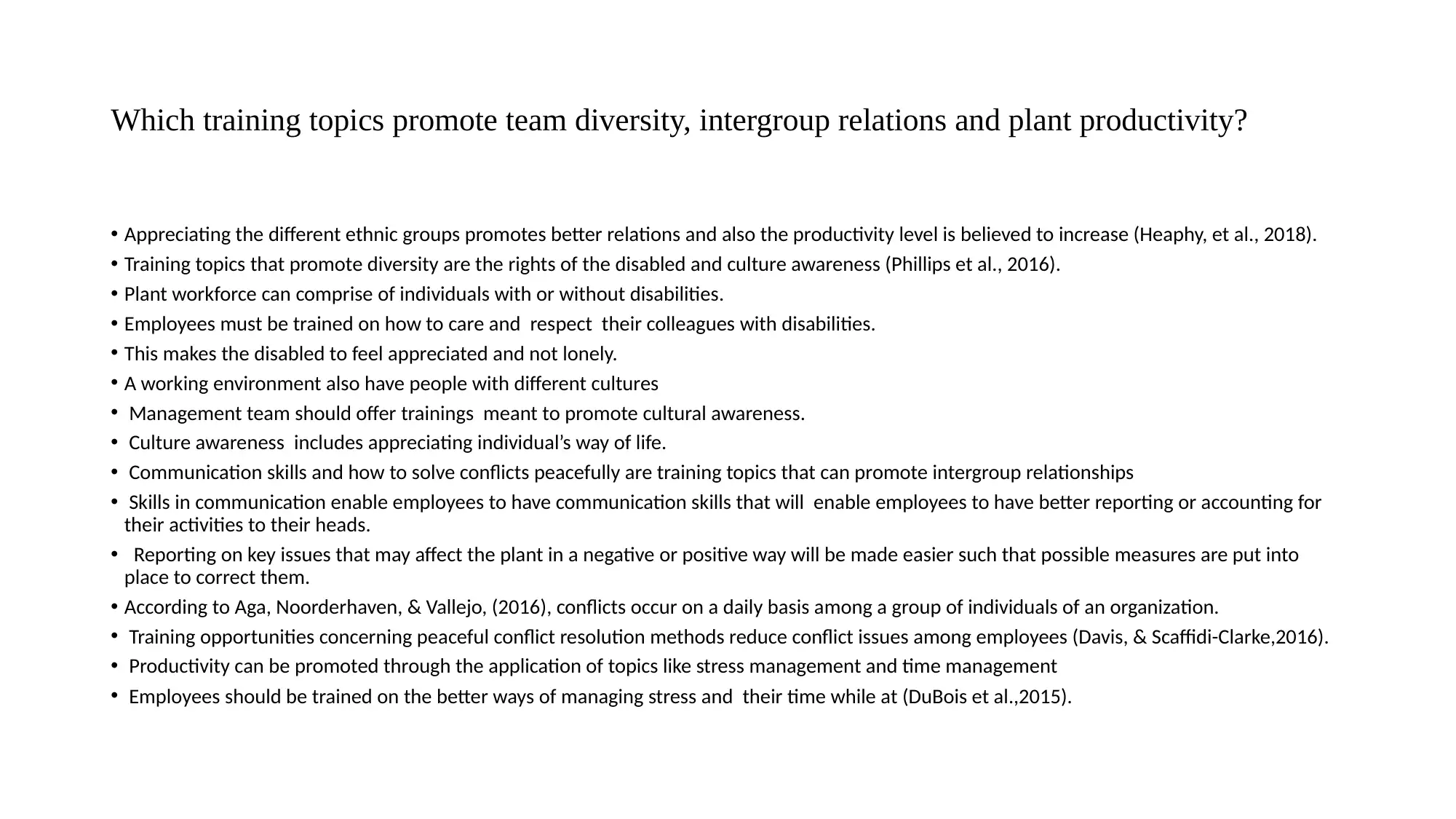
Which training topics promote team diversity, intergroup relations and plant productivity?
• Appreciating the different ethnic groups promotes better relations and also the productivity level is believed to increase (Heaphy, et al., 2018).
• Training topics that promote diversity are the rights of the disabled and culture awareness (Phillips et al., 2016).
• Plant workforce can comprise of individuals with or without disabilities.
• Employees must be trained on how to care and respect their colleagues with disabilities.
• This makes the disabled to feel appreciated and not lonely.
• A working environment also have people with different cultures
• Management team should offer trainings meant to promote cultural awareness.
• Culture awareness includes appreciating individual’s way of life.
• Communication skills and how to solve conflicts peacefully are training topics that can promote intergroup relationships
• Skills in communication enable employees to have communication skills that will enable employees to have better reporting or accounting for
their activities to their heads.
• Reporting on key issues that may affect the plant in a negative or positive way will be made easier such that possible measures are put into
place to correct them.
• According to Aga, Noorderhaven, & Vallejo, (2016), conflicts occur on a daily basis among a group of individuals of an organization.
• Training opportunities concerning peaceful conflict resolution methods reduce conflict issues among employees (Davis, & Scaffidi-Clarke,2016).
• Productivity can be promoted through the application of topics like stress management and time management
• Employees should be trained on the better ways of managing stress and their time while at (DuBois et al.,2015).
• Appreciating the different ethnic groups promotes better relations and also the productivity level is believed to increase (Heaphy, et al., 2018).
• Training topics that promote diversity are the rights of the disabled and culture awareness (Phillips et al., 2016).
• Plant workforce can comprise of individuals with or without disabilities.
• Employees must be trained on how to care and respect their colleagues with disabilities.
• This makes the disabled to feel appreciated and not lonely.
• A working environment also have people with different cultures
• Management team should offer trainings meant to promote cultural awareness.
• Culture awareness includes appreciating individual’s way of life.
• Communication skills and how to solve conflicts peacefully are training topics that can promote intergroup relationships
• Skills in communication enable employees to have communication skills that will enable employees to have better reporting or accounting for
their activities to their heads.
• Reporting on key issues that may affect the plant in a negative or positive way will be made easier such that possible measures are put into
place to correct them.
• According to Aga, Noorderhaven, & Vallejo, (2016), conflicts occur on a daily basis among a group of individuals of an organization.
• Training opportunities concerning peaceful conflict resolution methods reduce conflict issues among employees (Davis, & Scaffidi-Clarke,2016).
• Productivity can be promoted through the application of topics like stress management and time management
• Employees should be trained on the better ways of managing stress and their time while at (DuBois et al.,2015).
⊘ This is a preview!⊘
Do you want full access?
Subscribe today to unlock all pages.

Trusted by 1+ million students worldwide
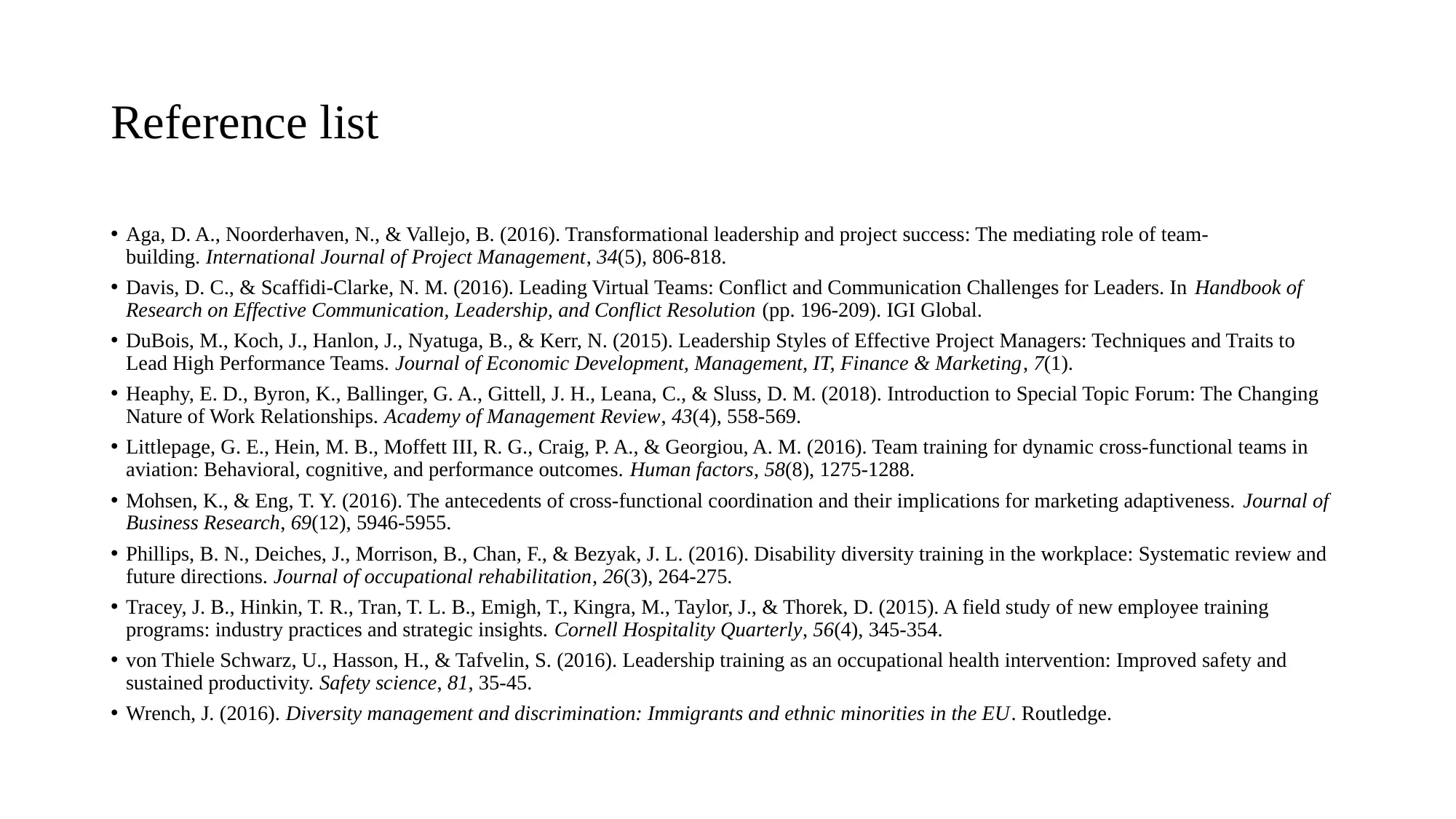
Reference list
• Aga, D. A., Noorderhaven, N., & Vallejo, B. (2016). Transformational leadership and project success: The mediating role of team-
building. International Journal of Project Management, 34(5), 806-818.
• Davis, D. C., & Scaffidi-Clarke, N. M. (2016). Leading Virtual Teams: Conflict and Communication Challenges for Leaders. In Handbook of
Research on Effective Communication, Leadership, and Conflict Resolution (pp. 196-209). IGI Global.
• DuBois, M., Koch, J., Hanlon, J., Nyatuga, B., & Kerr, N. (2015). Leadership Styles of Effective Project Managers: Techniques and Traits to
Lead High Performance Teams. Journal of Economic Development, Management, IT, Finance & Marketing, 7(1).
• Heaphy, E. D., Byron, K., Ballinger, G. A., Gittell, J. H., Leana, C., & Sluss, D. M. (2018). Introduction to Special Topic Forum: The Changing
Nature of Work Relationships. Academy of Management Review, 43(4), 558-569.
• Littlepage, G. E., Hein, M. B., Moffett III, R. G., Craig, P. A., & Georgiou, A. M. (2016). Team training for dynamic cross-functional teams in
aviation: Behavioral, cognitive, and performance outcomes. Human factors, 58(8), 1275-1288.
• Mohsen, K., & Eng, T. Y. (2016). The antecedents of cross-functional coordination and their implications for marketing adaptiveness. Journal of
Business Research, 69(12), 5946-5955.
• Phillips, B. N., Deiches, J., Morrison, B., Chan, F., & Bezyak, J. L. (2016). Disability diversity training in the workplace: Systematic review and
future directions. Journal of occupational rehabilitation, 26(3), 264-275.
• Tracey, J. B., Hinkin, T. R., Tran, T. L. B., Emigh, T., Kingra, M., Taylor, J., & Thorek, D. (2015). A field study of new employee training
programs: industry practices and strategic insights. Cornell Hospitality Quarterly, 56(4), 345-354.
• von Thiele Schwarz, U., Hasson, H., & Tafvelin, S. (2016). Leadership training as an occupational health intervention: Improved safety and
sustained productivity. Safety science, 81, 35-45.
• Wrench, J. (2016). Diversity management and discrimination: Immigrants and ethnic minorities in the EU. Routledge.
• Aga, D. A., Noorderhaven, N., & Vallejo, B. (2016). Transformational leadership and project success: The mediating role of team-
building. International Journal of Project Management, 34(5), 806-818.
• Davis, D. C., & Scaffidi-Clarke, N. M. (2016). Leading Virtual Teams: Conflict and Communication Challenges for Leaders. In Handbook of
Research on Effective Communication, Leadership, and Conflict Resolution (pp. 196-209). IGI Global.
• DuBois, M., Koch, J., Hanlon, J., Nyatuga, B., & Kerr, N. (2015). Leadership Styles of Effective Project Managers: Techniques and Traits to
Lead High Performance Teams. Journal of Economic Development, Management, IT, Finance & Marketing, 7(1).
• Heaphy, E. D., Byron, K., Ballinger, G. A., Gittell, J. H., Leana, C., & Sluss, D. M. (2018). Introduction to Special Topic Forum: The Changing
Nature of Work Relationships. Academy of Management Review, 43(4), 558-569.
• Littlepage, G. E., Hein, M. B., Moffett III, R. G., Craig, P. A., & Georgiou, A. M. (2016). Team training for dynamic cross-functional teams in
aviation: Behavioral, cognitive, and performance outcomes. Human factors, 58(8), 1275-1288.
• Mohsen, K., & Eng, T. Y. (2016). The antecedents of cross-functional coordination and their implications for marketing adaptiveness. Journal of
Business Research, 69(12), 5946-5955.
• Phillips, B. N., Deiches, J., Morrison, B., Chan, F., & Bezyak, J. L. (2016). Disability diversity training in the workplace: Systematic review and
future directions. Journal of occupational rehabilitation, 26(3), 264-275.
• Tracey, J. B., Hinkin, T. R., Tran, T. L. B., Emigh, T., Kingra, M., Taylor, J., & Thorek, D. (2015). A field study of new employee training
programs: industry practices and strategic insights. Cornell Hospitality Quarterly, 56(4), 345-354.
• von Thiele Schwarz, U., Hasson, H., & Tafvelin, S. (2016). Leadership training as an occupational health intervention: Improved safety and
sustained productivity. Safety science, 81, 35-45.
• Wrench, J. (2016). Diversity management and discrimination: Immigrants and ethnic minorities in the EU. Routledge.
1 out of 7
Related Documents
Your All-in-One AI-Powered Toolkit for Academic Success.
+13062052269
info@desklib.com
Available 24*7 on WhatsApp / Email
![[object Object]](/_next/static/media/star-bottom.7253800d.svg)
Unlock your academic potential
Copyright © 2020–2025 A2Z Services. All Rights Reserved. Developed and managed by ZUCOL.




